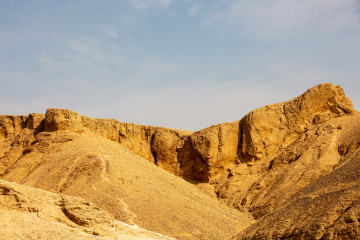

“The story of the world can be told from the bottom of the sea,” Bettany Hughes, an English historian, author and broadcaster, says when we discuss one of her latest projects, the podcast Dive & Dig.
Along with co-host Dr Lucy Blue, Hughes takes the listener on an underwater journey through some of the most interesting archaeological discoveries in the Mediterranean.
“There are so many amazing remains, and so much underexplored evidence, that if you think about it, ancient seas were the highways of humanity – people, soldiers, goods and ideas all travelled across them. It’s the most brilliant way to get a true picture of the story of the world.”
"All history can tell us about modern life because of the unbroken line of experience from prehistory right through to us. We are the inheritors of our ancestors’ present"
Maritime archaeology is a discipline which studies human interaction with the sea. It requires specialism due to the tricky nature of accessing and working underwater sites.
“You’ve got to desalinate the material you’ve got out from under the sea, you’ve got to depressurise yourself, and there are certain seasons you can’t operate in because of visibility,” Bettany explains. “It’s a very complex, highly intensive set of operations, and it costs quite a lot of money to do it.”
Nevertheless, underwater archaeology has led historians to famous shipwrecks and lost cities; over the years, sponge divers discovered a Roman-period shipwreck in the Aegean Sea which contained marble and bronze artefacts, while another group of archaeologists stumbled upon a preserved settlement of Atlit-Yam off the shores of historic Palestine.
The Dive & Dig presenters speak to underwater archaeologists working at key sites – from sunken cities in Italy to the harbours of Turkey’s capital.
However, it is the episode about Egypt’s Wadi al-Jarf site – the oldest known artificial sea harbour in the world – that catches The New Arab’s attention, as discoveries there are demystifying age-old uncertainties around the construction of the Pyramids.
The Wadi al-Jarf site is partly submerged and located on the shores of the Red Sea. The harbour was developed nearly 4,500 years ago and contains 30 caves, some of which have preserved dismantled wooden boats and a papyrus archive telling the story of the site.
Archaeologists estimate the site to have been built during the Fourth Dynasty of Egypt, around the time Pharaoh Khufu ordered the construction of the Great Pyramid of Giza.
Some of the pyramid’s stone blocks average over two tonnes a piece, with the largest weighing as much as fifteen tonnes each.
This fact has caused much theorising about how the pyramid was built, as the technology of the time would have been more limited than today. However, new archaeological findings are getting us closer to the truth.
Bettany interviewed Egyptologist Pierre Tallet for the Dive & Dig episode and was overjoyed to discuss his team’s discoveries at the Wadi al-Jarf site since 2011.
“There’s a whole logbook about getting material up the Nile so that the Great Pyramid can be constructed,” she says, commenting on his findings. “We know the source of the material; we get an idea of how many people are involved, the complexity of the organisation, and even the bits of the riverbanks [workers would] hang out at to rest before going up to the Great Pyramids of Giza.”
Such discoveries are finally aiding experts to comprehend the engineering of grand monuments like the Pyramid of Giza and shed more light on the people involved in their creation.
|
Most excitingly for Hughes, ancient artefacts connect the past to the present. “All history can tell us about modern life because of the unbroken line of experience from prehistory right through to us. We are the inheritors of our ancestors’ present.”
She explores this unbroken line of experience in the new season of Treasures of the World, the historian’s Channel 4 documentary, by looking to the past to see how humans collaborated and were resilient in times of hardship. “It’s a celebratory series, and it looks at good news stories from history because we need a bit of that on our television screens.”
New episodes follow Hughes’ journey in Arabia, Turkey, Cyprus, Oman, Albania, Jordan and along the Silk Roads of Azerbaijan, taking her back to the early Stone Age.
During her time in southern Turkey, she saw an 11,000-year-old stone-carved storyboard in a villager’s cellar, which she says was a real highlight.
“It shows a man being attacked by beasts and somebody doing a ritual dance. It was extraordinary.”
A local archaeologist led her to the discovery, which she feels is at the heart of her work. “I’m always aware that I’m a guest in other people’s countries, so to be a vehicle that people can use to communicate their history with the wider world is a real opportunity to share untold stories from untold voices."
Diyora Shadijanova is an award-winning multi-media journalist, editor and writer. She works on stories about art, the environment, digital and popular culture, lifestyle, history and politics.
Follow her on Twitter: @thediyora

![The anchors on the coastal camps [photo credit: Wadi el-Jarf Archaeological Mission]](/sites/default/files/styles/medium_16_9/public/2023-03/4.-the-anchors-on-the-coastal-camps%20%C2%A9%20Wadi%20el-Jarf%20Archaeological%20Mission%20%281%29.jpg?h=764bf9c2&itok=TWIxxIwO)
![The picture shows a papyrus displayed in the Egyptian Museum in the capital Cairo during an exhibition for a collection of King Khufu's papyri discovered in Wadi el-Jarf. papers telling of the daily lives of port workers who transported huge limestone blocks to Cairo during King Khufu's rule to build the Great Pyramid, intended to be his burial structure [Getty Images]](/sites/default/files/styles/medium_16_9/public/2023-03/GettyImages-547297874%20%281%29.jpg?h=199d8c1f&itok=balbPDag)



 Follow the Middle East's top stories in English at The New Arab on Google News
Follow the Middle East's top stories in English at The New Arab on Google News


